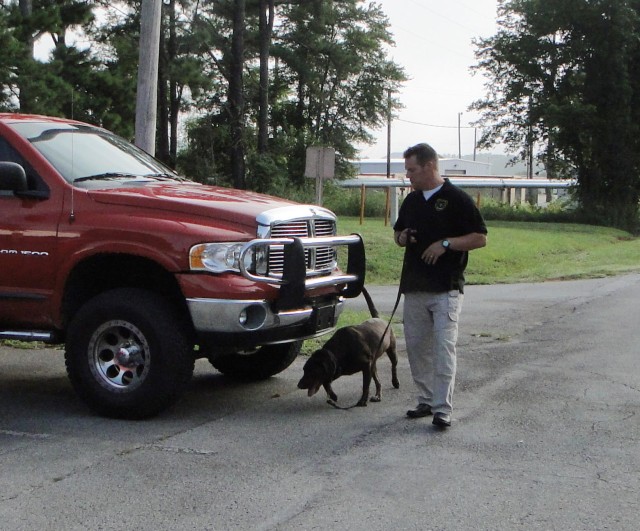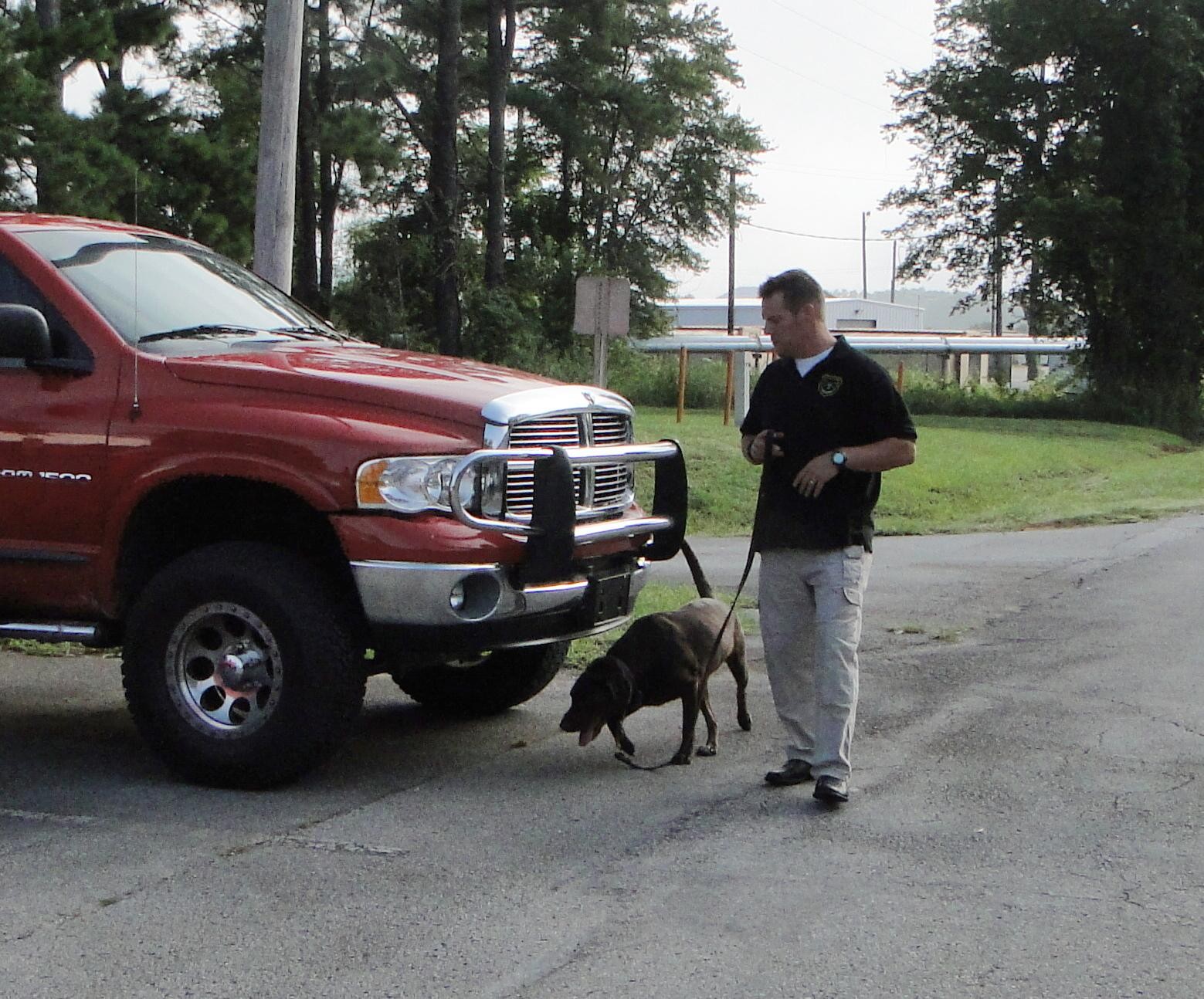
It was hard not to notice the exuberant, happy-go-lucky English Labrador retriever bounding through the parking lot at building 5436 on Aug. 3.
But there was much more to this chocolate lab than the friendly look on his face.
Browning, who was visiting with his handler Troy Chaffee, is a highly trained, bomb-sniffing police dog. He is trained to recognize more than 22,000 chemical odors singularly or combined to make explosives.
Browning and Chaffee, a deputy sheriff, are a certified ordnance recognition team and members of the King County Sheriff's Department in Seattle, Wash.
"Working with Browning is a great job. It's the best job I've ever had in the department," Chaffee said. "Browning has been the best partner I've ever had, hands down. No matter what's going on or what the weather is like, he will absolutely work with me at any time. That endears him to me."
Chaffee, a former active duty and Reserve Soldier, was at Redstone Arsenal to attend the FBI's Hazardous Devices School, where he was certified as a bomb technician. He is the son of Tom Chaffee, director of USATA's Engineering, Acquisition and Logistics Directorate. As a favor to his father, Chaffee provided a demonstration of Browning's capabilities for USATA employees Aug. 3.
In the first demonstration, the 5-year-old lab, who was on a leash held by Chaffee, uncovered simulated bomb-smelling material that had been planted on an employee. In a matter of seconds, Browning sniffed around the group of six employees and sat down in front of the employee who had the simulated material in his pocket. Then, just as quickly, Browning found simulated bomb-smelling material hidden in an outdoor picnic area and then hidden among some parked cars.
"A change in his body language tells me he's got an odor," Chaffee said, as he followed Browning around cars.
Following each demonstration, Chaffee tossed a chew toy to Browning for some play time.
"His reward for finding a bomb is a work toy. In training, he goes from toy to toy to toy," Chaffee said.
When on duty, Browning and Chaffee perform bomb sweeps of various locations in and around Seattle at gatherings of dignitaries and at public events, visit crime scenes to locate guns, shell casing and bomb fragments, and provide protection for visiting dignitaries.
"We have a busy schedule at home at sporting events, dignitary visits and for VIPs," Chaffee said. "Browning has met (computer entrepreneur and multi-millionaire) Bill Gates and he has protected (former president) Jimmy Carter, who had his picture taken with Browning. He is friends with the players of the Seattle Mariners baseball team. They know him by name and he knows them by smell.
"He can trail scents through airplanes, cars, boats and buses. He is often used to sweep ferries in Seattle. He can sweep high and low, under and over seats. He can locate someone wearing a suicide vest and he'll trail them through a crowd. He will identify a moving scent and he can detect even the smallest trace of explosive odor."
Browning is especially popular at sporting events and other large public gatherings, where he is beginning to be recognized by the general public.
"He is really a preventive measure and a presence to deter people," Chaffee said. "There are 64,000 people who fill Seahawk Stadium for a football game. We have a minimum of 10 dogs from various agencies that will work an event that large. We sweep locker rooms, bathrooms, media rooms and we walk the game. He scans the crowd as he works. I often feel like the stalker who follows the cool dog around."
If he's not working, Browning is trained at least twice a day.
"Keeping him working is keeping him healthy," Chaffee said. "In the last year, we've done 300 dog deployments. We do crime scene work all over the Seattle area because he can find guns and shell cases. Trained dogs really help to cut down on man hours for sheriff's departments and other agencies."
Trained police dogs have become more common since 9/11.
"It's really been a boon to homeland security to have these dogs," Chaffee said. "After 9/11, there was an increase in bomb dog capability in the states. Most airports have them. Our department now has two. But we are looking for three more because we have gotten a light rail system and that will require more work from our dogs."
Dogs are especially good for odor detection because their sense of smell is so keen. Their smell sense can be 400 to 800 times better than a human's sense of smell.
Browning was originally trained by the Department of Defense for a Navy SEAL team being deployed to Iraq. That mission was canceled and Browning was then sold to an Explosive Ordnance Disposable think tank group commissioned by the Department of Homeland Security that received a grant to train dogs for law enforcement agencies. About one and a half years ago, Chaffee met Browning at the Blackwater Corp. in Moyock, N.C., where Browning had been trained by the Virginia State Police Working Dog Association to recognize chemical odors used in making explosives.
The Browning/Chaffee team trained together at Blackwater for six weeks, passing numerous tests for locating and identifying a variety of bomb and explosive simulants. Following the training, they were certified and have since been recertified by the National Ordnance Recognition Test program in Reno, Nev.
As his handler, Chaffee must rely on his own judgment when deploying Browning. He won't use the dog at a scene where explosives are obviously evident.
"There's a fine line between the difference in an unattended package and a suspicious package. What's the difference' I will easily run Browning on a package on a bus because I know the chances are it is just an unattended package," Chaffee said.
"As a handler, if I think there is a real bomb, I won't deploy Browning, especially since I know if it looks suspicious enough we are going to have to put on bomb suits and do something about it. There are so many scenarios, though, that can turn out to be more dangerous that thought. The sad thing is Browning is a tool and there's been many bomb dogs, especially overseas, who pay the price for being a bomb dog."
He also must judge when Browning is at his best for an assignment.
"On his best day, Browning is a dog," he said. "Sometimes dogs don't do anything you want them to do. You have to work with them. If a dog doesn't find a gun or evidence of a gun in 30 to 45 minutes, then it's time for the metal detectors."
Among his many police certifications, Chaffee is also a trained expert and instructor with hazardous material detection and disposal. Often, he is called out to assist at the site of meth labs. But he won't take Browning on these assignments because he doesn't want the dog to inhale the poisonous odors.
Although Chaffee's demonstration was a one-time event for USATA employees, the Directorate of Emergency Services has a canine unit. The unit's police dogs are available for demonstrations upon request. To request a demonstration, call 876-8090.

Social Sharing